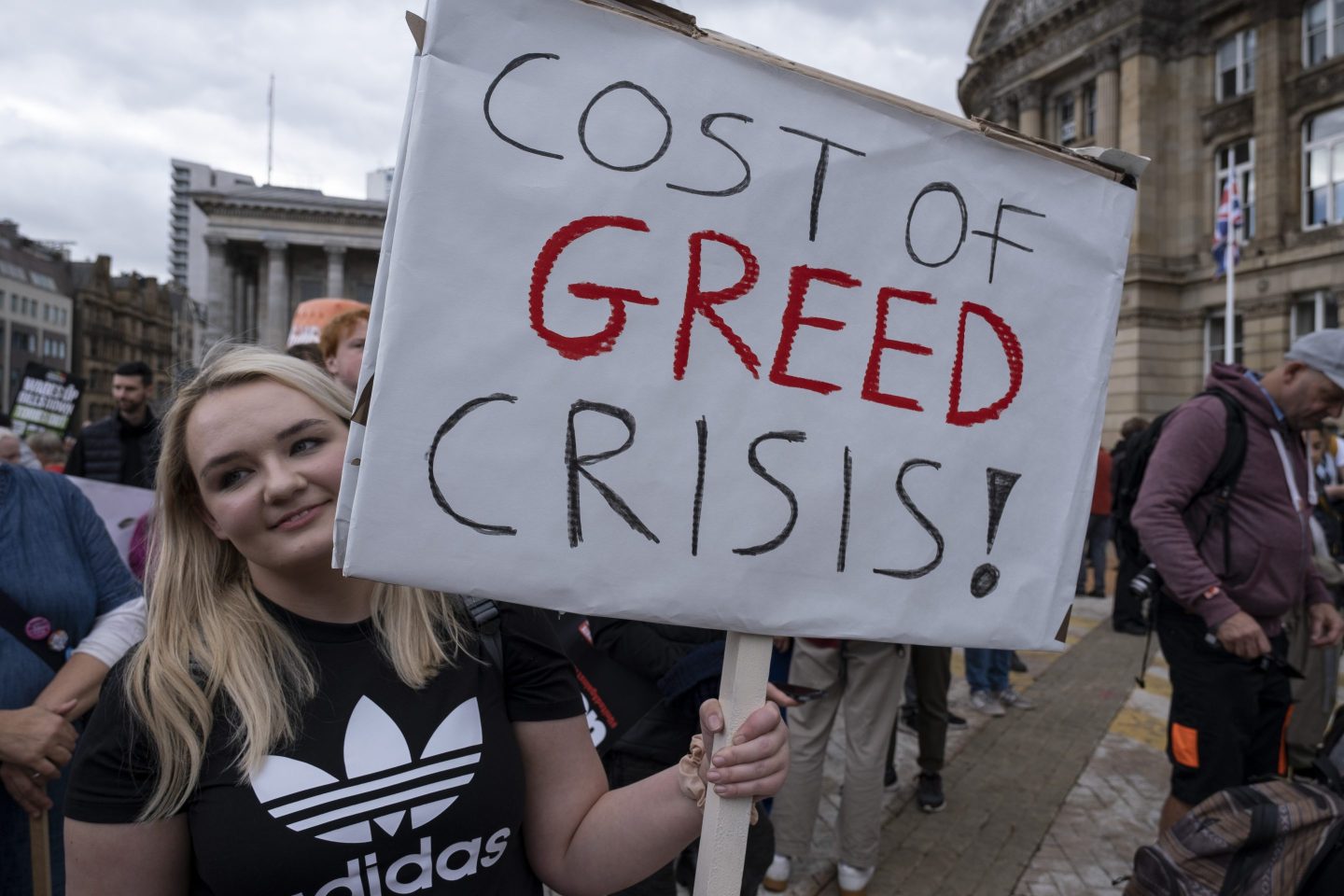
當成本上漲的時候,利潤是否也會增長?這并不是資本主義的運行方式,但卻是最近的趨勢。一年多來,美國以及全世界的消費者和企業都備受惡性通脹的折磨。但成本暴漲并沒有阻止企業賺取創紀錄的利潤。去年,《財富》500強公司營收16.1萬億美元,利潤達到創紀錄的1.8萬億美元。以左翼為主的政治人物針對這種現象發出了警告,例如伯尼·桑德斯在國會的講話,或者喬恩·斯圖爾特最近對美國前財長拉里·薩默斯的質問。但現在,一位來自全球歷史最悠久、規模最大的投資銀行之一的經濟學家也發出了同樣的警告。
阿爾伯特·愛德華茲在有159年歷史的法國興業銀行(Société Générale)擔任全球策略師。他最近發表了一篇言辭激烈的報告,分析了所謂“貪婪性通脹”這種現象。他表示,企業,尤其是在美國、英國等發達經濟體,利用疫情期間原材料成本上漲和俄烏沖突作為“借口”,趁機漲價,將利潤率提高到新的水平。這家法國投資銀行不僅歷史悠久,它還是金融穩定性委員會(Financial Stability Board)選定的“系統重要性”銀行之一。金融穩定性委員會是二十國集團的跨國組織,致力于保障全球金融系統的安全。
此外,愛德華茲在周二版的《每周全球策略》(Global Strategy Weekly)中寫道,當前企業貪婪性通脹的水平,是他在金融領域從業四十年來“前所未見的”和“令人震驚的”。堪薩斯城聯邦儲備銀行(Federal Reserve Bank of Kansas City)1月份的一項研究發現,與整個經濟歷史相比,在2021年,企業價格與生產成品的比率上漲,即“加成增長”,變成了推動通脹上漲的一個更加重要的因素。
通常情況下,尤其是經濟增長放緩時,產品價格和勞動力成本上漲會擠壓企業的利潤率。但愛德華茲認為,經濟分析局(Bureau of Economic Analysis,BEA)上周發布的數據顯示,在第四季度,企業利潤率與成本的比率依舊接近歷史最高水平。這位策略師表示,他曾假設隨著經濟增長放緩,在去年年底,利潤率應該“大幅下降”,但事實相反,“我大錯特錯!”
愛德華茲還表示,他擔心如果消費者持續受到通貨膨脹的折磨,美國和其他國家的企業“超高的利潤率”可能最終“引發社會動蕩”。
他警告稱:“貪婪性通脹必須結束。否則,我們可能會看到資本主義的末日。這是政策制定者無法再忽視的一個嚴重問題。”
愛德華茲的報告意義重大,它讓一種迄今為止一直代表進步派立場的觀點進入主流視野。例如,上個月,前《每日秀》(Daily Show)主持人喬恩·斯圖爾特在Apple TV的新節目《The Problem》中采訪了拉里·薩默斯,就貪婪性通脹問題進行了辯論。兩人在爭論美聯儲為應對通脹、通過加息壓低工資的做法是否正確時,斯圖爾特提出:“我們為什么不想方設法降低企業的利潤?因為據估計,企業利潤要為30%或者40%的通脹負責?”
薩默斯立即回答稱,他并不認為“企業突然變得貪婪這種觀點站得住腳。”愛德華茲卻似乎認為,這種觀點有理有據。
是時候實行物價管制了?
愛德華茲提出了解決貪婪性通脹上漲的一個有爭議的解決方案。他表示,這個解決方案表明他對資本主義體制的“信心減弱”。愛德華茲表示,對于這類問題有一個工具,那就是上世紀70年代的物價管制,這對于“經歷過當時物價和收入政策失敗的人們來說”或許是不可思議的轉變。
物價管制,即由政府規定允許企業向消費者收取的價格,曾經備受指責,從公元前1595年第一個巴比倫帝國的滅亡,到上世紀70年代尼克松和卡特政府時期加油站排起的長隊,都被歸咎于物價管制。有一個最常見的例子被用于證明物價管制極其愚蠢,那就是羅馬帝國皇帝戴克里先。公元301年,為了應對失控的通貨膨脹,他頒布了勞動力、商品的“最高物價法令”。該法令規定違者將被處死,最終卻起到了負面作用,引發了商品短缺,依賴政府小麥,最終導致該法令被廢除。
愛德華茲表示,因為這段歷史,他的許多同事“不太贊同執行物價管制”,但他認為物價管制可能是合理的手段,因為“有些情況似乎已經脫離了資本主義的范疇。”
這位策略師引用了馬薩諸塞大學阿默斯特分校(University of Massachusetts Amherst)經濟學家伊莎貝拉·韋伯和伊凡·瓦斯納的論文《賣方的通脹、利潤與沖突:為什么大企業突然漲價?》(Sellers’ Inflation, Profits and Conflict: Why Can Large Firms Hike Prices in an Emergency?)。這篇論文發現,企業在疫情期間“哄抬物價”,并認為臨時物價管制是防止哄抬物價導致的“螺旋式通脹”的唯一方法。
愛德華茲認為:“結合他們對于如何應對貪婪性通脹的結論,物價管制似乎是一種最受歡迎的控制通脹的方法。”(財富中文網)
翻譯:劉進龍
審校:汪皓
當成本上漲的時候,利潤是否也會增長?這并不是資本主義的運行方式,但卻是最近的趨勢。一年多來,美國以及全世界的消費者和企業都備受惡性通脹的折磨。但成本暴漲并沒有阻止企業賺取創紀錄的利潤。去年,《財富》500強公司營收16.1萬億美元,利潤達到創紀錄的1.8萬億美元。以左翼為主的政治人物針對這種現象發出了警告,例如伯尼·桑德斯在國會的講話,或者喬恩·斯圖爾特最近對美國前財長拉里·薩默斯的質問。但現在,一位來自全球歷史最悠久、規模最大的投資銀行之一的經濟學家也發出了同樣的警告。
阿爾伯特·愛德華茲在有159年歷史的法國興業銀行(Société Générale)擔任全球策略師。他最近發表了一篇言辭激烈的報告,分析了所謂“貪婪性通脹”這種現象。他表示,企業,尤其是在美國、英國等發達經濟體,利用疫情期間原材料成本上漲和俄烏沖突作為“借口”,趁機漲價,將利潤率提高到新的水平。這家法國投資銀行不僅歷史悠久,它還是金融穩定性委員會(Financial Stability Board)選定的“系統重要性”銀行之一。金融穩定性委員會是二十國集團的跨國組織,致力于保障全球金融系統的安全。
此外,愛德華茲在周二版的《每周全球策略》(Global Strategy Weekly)中寫道,當前企業貪婪性通脹的水平,是他在金融領域從業四十年來“前所未見的”和“令人震驚的”。堪薩斯城聯邦儲備銀行(Federal Reserve Bank of Kansas City)1月份的一項研究發現,與整個經濟歷史相比,在2021年,企業價格與生產成品的比率上漲,即“加成增長”,變成了推動通脹上漲的一個更加重要的因素。
通常情況下,尤其是經濟增長放緩時,產品價格和勞動力成本上漲會擠壓企業的利潤率。但愛德華茲認為,經濟分析局(Bureau of Economic Analysis,BEA)上周發布的數據顯示,在第四季度,企業利潤率與成本的比率依舊接近歷史最高水平。這位策略師表示,他曾假設隨著經濟增長放緩,在去年年底,利潤率應該“大幅下降”,但事實相反,“我大錯特錯!”
愛德華茲還表示,他擔心如果消費者持續受到通貨膨脹的折磨,美國和其他國家的企業“超高的利潤率”可能最終“引發社會動蕩”。
他警告稱:“貪婪性通脹必須結束。否則,我們可能會看到資本主義的末日。這是政策制定者無法再忽視的一個嚴重問題。”
愛德華茲的報告意義重大,它讓一種迄今為止一直代表進步派立場的觀點進入主流視野。例如,上個月,前《每日秀》(Daily Show)主持人喬恩·斯圖爾特在Apple TV的新節目《The Problem》中采訪了拉里·薩默斯,就貪婪性通脹問題進行了辯論。兩人在爭論美聯儲為應對通脹、通過加息壓低工資的做法是否正確時,斯圖爾特提出:“我們為什么不想方設法降低企業的利潤?因為據估計,企業利潤要為30%或者40%的通脹負責?”
薩默斯立即回答稱,他并不認為“企業突然變得貪婪這種觀點站得住腳。”愛德華茲卻似乎認為,這種觀點有理有據。
是時候實行物價管制了?
愛德華茲提出了解決貪婪性通脹上漲的一個有爭議的解決方案。他表示,這個解決方案表明他對資本主義體制的“信心減弱”。愛德華茲表示,對于這類問題有一個工具,那就是上世紀70年代的物價管制,這對于“經歷過當時物價和收入政策失敗的人們來說”或許是不可思議的轉變。
物價管制,即由政府規定允許企業向消費者收取的價格,曾經備受指責,從公元前1595年第一個巴比倫帝國的滅亡,到上世紀70年代尼克松和卡特政府時期加油站排起的長隊,都被歸咎于物價管制。有一個最常見的例子被用于證明物價管制極其愚蠢,那就是羅馬帝國皇帝戴克里先。公元301年,為了應對失控的通貨膨脹,他頒布了勞動力、商品的“最高物價法令”。該法令規定違者將被處死,最終卻起到了負面作用,引發了商品短缺,依賴政府小麥,最終導致該法令被廢除。
愛德華茲表示,因為這段歷史,他的許多同事“不太贊同執行物價管制”,但他認為物價管制可能是合理的手段,因為“有些情況似乎已經脫離了資本主義的范疇。”
這位策略師引用了馬薩諸塞大學阿默斯特分校(University of Massachusetts Amherst)經濟學家伊莎貝拉·韋伯和伊凡·瓦斯納的論文《賣方的通脹、利潤與沖突:為什么大企業突然漲價?》(Sellers’ Inflation, Profits and Conflict: Why Can Large Firms Hike Prices in an Emergency?)。這篇論文發現,企業在疫情期間“哄抬物價”,并認為臨時物價管制是防止哄抬物價導致的“螺旋式通脹”的唯一方法。
愛德華茲認為:“結合他們對于如何應對貪婪性通脹的結論,物價管制似乎是一種最受歡迎的控制通脹的方法。”(財富中文網)
翻譯:劉進龍
審校:汪皓
When costs go up, so do profits? That’s not how capitalism is supposed to work, but that is the recent trend. For over a year now, consumers and businesses, both in the U.S. and worldwide, have struggled with stubborn inflation. But the soaring costs haven’t prevented corporations from raking in record profits. The companies in last year’s Fortune 500 alone generated an all-time high $1.8 trillion in profit on $16.1 trillion in revenue. Voices largely on the left side of the political spectrum have been sounding the alarm on this—think: Bernie Sanders in Congress or Jon Stewart’s recent grilling of former Treasury Secretary Larry Summers—but now an economist at one of the world’s oldest and greatest investment banks is singing the same tune.
Albert Edwards, a global strategist at the 159-year-old bank Société Générale, just released a blistering note on the phenomenon that has come to be called Greedflation. Corporations, particularly in developed economies like the U.S. and U.K., have used rising raw material costs amid the pandemic and the war in Ukraine as an “excuse” to raise prices and expand profit margins to new heights, he said. And the French investment bank isn’t just historic: It’s one of the select banks considered to be “systemically important” by the Financial Stability Board, the G20’s international body dedicated to safeguarding the global financial system.
Furthermore, Edwards wrote, in the Tuesday edition of his Global Strategy Weekly, after four decades of working in finance, he’s never seen anything like the “unprecedented” and “astonishing” levels of corporate Greedflation in this economic cycle. To his point, a January study from the Federal Reserve Bank of Kansas City found that “markup growth”—the increase in the ratio between the price a firm charges and its cost of production—was a far more important factor driving inflation in 2021 than it has been throughout economic history.
Typically, higher commodity prices and labor costs squeeze corporate margins, especially if the economy is slowing. But Edwards pointed to data released by the Bureau of Economic Analysis (BEA) last week that showed profit margins still near a record high relative to costs in the fourth quarter. The strategist said he assumed margins would have “declined sharply” at the end of last year as the economy slowed, but instead, “How wrong I was!”
Edwards added that he fears the “super-normal profit margins” of corporations in the U.S. and abroad could eventually “inflame social unrest” if consumers continue to struggle with inflation.
“The end of Greedflation must surely come. Otherwise, we may be looking at the end of capitalism,” he warned. “This is a big issue for policymakers that simply cannot be ignored any longer.”
Edwards’s note could be significant in bringing a viewpoint that has thus far lived on the progressive fringe into the mainstream. For instance, a debate over Greedflation broke out last month, during former Daily Show host Jon Stewart’s interview with Larry Summers on his new Apple TV show, The Problem. As Stewart and Summers debated whether the Fed was right to pressure wages to fall by raising interest rates in its inflation fight, Stewart pivoted: “Why aren’t we attacking corporate profit in any way? Because that’s been estimated to be 30% of inflation, 40% of inflation?”
Summers was quick to respond that he didn’t think it was “a tenable view that all of a sudden corporations became greedy.” Edwards seems to be saying that it actually is quite tenable.
Time to control prices?
Edwards proposed a controversial solution to fix the rise of Greedflation, which he said reflects his “weakening confidence” in the capitalist system itself. In a once unthinkable twist to “those of us who lived through the failed prices and incomes policies of the 1970s,” Edwards said there is a tool for this kind of problem, and it’s from that same decade: price controls.
Price controls—or when a government mandates the prices businesses are allowed to charge consumers—have been blamed for everything from the fall of the first Babylonian Empire in 1595 BC to the long lines at the gas pump of the Nixon and Carter administrations in the ’70s. One of the most common stories about the supposed folly of price controls comes from the Roman emperor Diocletian, who enacted an “edict on maximum prices” for labor, commodities, and more to combat rampant inflation in AD 301. But the edict, which included a death penalty for anyone who broke it, eventually backfired, creating a scarcity of goods and reliance on government wheat that led to its repeal.
Edwards noted that many of his colleagues are “less sympathetic to the use of price controls” because of this history, but he argues their use may be warranted because “something seems to have broken with capitalism.”
The strategist referenced a paper by University of Massachusetts Amherst economists Isabella Weber and Evan Wasner, titled, “Sellers’ Inflation, Profits and Conflict: Why Can Large Firms Hike Prices in an Emergency?” which found that corporations engaged in “price gouging” during the pandemic and argued temporary price controls may be the only way to prevent the “inflationary spirals” that could come as a result of this gouging.
“Looking at their conclusions on how to deal with Greedflation, price controls seem to emerge as a favorite method of control,” Edwards argued.






